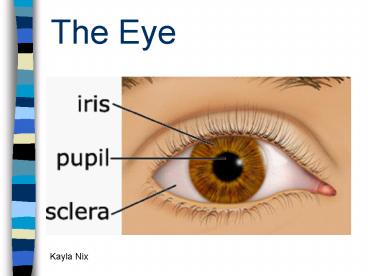The Eye - PowerPoint PPT Presentation
1 / 8
Title:
The Eye
Description:
The Eye Kayla Nix The Eye And It s Function Controlling the Light Parts of the Eye lens The transparent crystalline lens of the eye is located immediately behind ... – PowerPoint PPT presentation
Number of Views:75
Avg rating:3.0/5.0
Title: The Eye
1
The Eye
Kayla Nix
2
The Eye And Its Function
The human eye is a very complex organ. The eye
uses light to allow us to see. Light travels
through the cornea in the front of the eye to the
lens. The cornea and lens help focus what you
are seeing and focuses the light on the retina.
Then the cells in the retina send an impulse to
the brain and then you actually see the image.
3
Controlling the Light
The iris and pupil of the eye control how much
light is let into the back of the eye. When the
eye needs to absorb more light the pupil
enlarges. When the eye needs less light the
pupil gets smaller.
The pupil is the black part of the eye.
4
Parts of the Eye
- lens
- The transparent crystalline lens of the eye
is located immediately behind the iris. - cornea
- The cornea is a transparent dome which
serves as the outer window of the eye. The cornea
is the most powerful structure focusing light
entering the eye. - retina
- The retina is the innermost layer of the eye. It
is composed of nerve tissue which senses the
light entering the eye. - The retina sends impulses through the optic
nerve back to the brain, which translates the
impulses into images that we see. - There are 4 types of light-sensitive receptors
found in the retina - rods
- cones that absorb long-wavelength light (red)
- cones that absorb middle-wavelength light (green)
- cones that absorb short-wavelength light (blue)
5
Parts of the Eye Part 2
- pupil
- The pupil is the hole in the center of the
eye where light passes through. - iris
- The iris is the colored part of the eye. It
is a thin diaphragm composed mostly of connective
tissue and smooth muscle fibers. The iris lies
between the cornea and the crystalline lens. - optic nerve
- The optic nerve is a continuation of the
axons of the ganglion cells in the retina. It
acts acts like a cable connecting the eye with
the brain. - The optic nerve is also called the cranial
nerve II. - sclera
- The sclera is the white, opaque portion of
the eye. It provides protection and serves as an
attachment for the extra-ocular muscles which
move the eye.
6
Diagram of the Eye
7
Rods and Cones
- There are close to 120 million rods in the human
eye. - The cone of the eye help detect color.
- There are six to seven million cone cells in the
eye. - The rod is used at night to allow you to see.
8
See you later!































